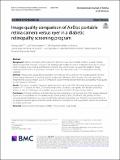| dc.contributor.author | Brant, Rodrigo | |
| dc.contributor.author | Nakayama, Luis Filipe | |
| dc.contributor.author | de Oliveira, Talita Virgínia Fernandes | |
| dc.contributor.author | de Oliveira, Juliana Angelica Estevão | |
| dc.contributor.author | Ribeiro, Lucas Zago | |
| dc.contributor.author | Richter, Gabriela Dalmedico | |
| dc.contributor.author | Rodacki, Rafael | |
| dc.contributor.author | Penha, Fernando Marcondes | |
| dc.date.accessioned | 2024-06-17T18:29:58Z | |
| dc.date.available | 2024-06-17T18:29:58Z | |
| dc.date.issued | 2024-06-14 | |
| dc.identifier.issn | 2056-9920 | |
| dc.identifier.uri | https://hdl.handle.net/1721.1/155284 | |
| dc.description.abstract | Background
Diabetic retinopathy (DR) stands as the foremost cause of preventable blindness in adults. Despite efforts to expand DR screening coverage in the Brazilian public healthcare system, challenges persist due to various factors including social, medical, and financial constraints. Our objective was to evaluate the quality of images obtained with the AirDoc, a novel device, compared to Eyer portable camera which has already been clinically validated.
Methods
Images were captured by two portable retinal devices: AirDoc and Eyer. The included patients had their fundus images obtained in a screening program conducted in Blumenau, Santa Catarina. Two retina specialists independently assessed image’s quality. A comparison was performed between both devices regarding image quality and the presence of artifacts.
Results
The analysis included 129 patients (mean age of 61 years), with 29 (43.28%) male and an average disease duration of 11.1 ± 8 years. In Ardoc, 21 (16.28%) images were classified as poor quality, with 88 (68%) presenting artifacts; in Eyer, 4 (3.1%) images were classified as poor quality, with 94 (72.87%) presenting artifacts.
Conclusions
Although both Eyer and AirDoc devices show potential as screening tools, the AirDoc images displayed higher rates of ungradable and low-quality images, that may directly affect the DR and DME grading. We must acknowledge the limitations of our study, including the relatively small sample size. Therefore, the interpretations of our analyses should be approached with caution, and further investigations with larger patient cohorts are warranted to validate our findings. | en_US |
| dc.publisher | Springer Science and Business Media LLC | en_US |
| dc.relation.isversionof | 10.1186/s40942-024-00559-z | en_US |
| dc.rights | Creative Commons Attribution | en_US |
| dc.rights.uri | https://creativecommons.org/licenses/by/4.0/ | en_US |
| dc.source | BioMed Central | en_US |
| dc.title | Image quality comparison of AirDoc portable retina camera versus eyer in a diabetic retinopathy screening program | en_US |
| dc.type | Article | en_US |
| dc.identifier.citation | Brant, R., Nakayama, L.F., de Oliveira, T.V.F. et al. Image quality comparison of AirDoc portable retina camera versus eyer in a diabetic retinopathy screening program. Int J Retin Vitr 10, 43 (2024). | en_US |
| dc.contributor.department | Harvard--MIT Program in Health Sciences and Technology. Laboratory for Computational Physiology | |
| dc.relation.journal | International Journal of Retina and Vitreous | en_US |
| dc.identifier.mitlicense | PUBLISHER_CC | |
| dc.eprint.version | Final published version | en_US |
| dc.type.uri | http://purl.org/eprint/type/JournalArticle | en_US |
| eprint.status | http://purl.org/eprint/status/PeerReviewed | en_US |
| dc.date.updated | 2024-06-16T03:13:22Z | |
| dc.language.rfc3066 | en | |
| dc.rights.holder | The Author(s) | |
| dspace.date.submission | 2024-06-16T03:13:22Z | |
| mit.journal.volume | 10 | en_US |
| mit.journal.issue | 1 | en_US |
| mit.license | PUBLISHER_CC | |
| mit.metadata.status | Authority Work and Publication Information Needed | en_US |
